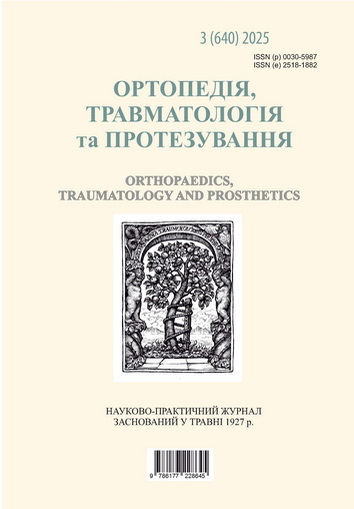BONE MINERAL DENSITY AND VITAMIN D STATUS IN WAR VETERANS AFTER LOWER LIMB AMPUTATION
DOI:
https://doi.org/10.15674/0030-59872025312-19Keywords:
Lower-limb amputation, bone mineral density, 25(ОН)D, DХA, osteoporosisAbstract
The study aimed to assess bone mineral density (BMD) and vitamin D status in war veterans after unilateral lower limb amputation (ULLA). Methods. In the case-control study, 64 men aged 20–54 years were examined and divided into two groups: healthy subjects without any diseases or conditions affecting bone metabolism (control group) and men who received ULLA (study group). The analysis was performed depending on the presence and level of amputation. BMD was measured by two energy X-ray absorptiometry, and vitamin D status was assessed by serum dihydroxyvitamin D (25(OH)D) levels. Results. Significantly lower BMD values were found in the femoral neck and the hip of t he a mputated ( p = 0 .00002 a nd p = 0.0002, r espectively), byt not in the contralateral side or lumbar spine in amputees compared with controls. Significantly worse BMD indices were found in the femoral neck and the hip in men with transfemoral amputation compared with those with transtibial amputation at the level of the amputation, but not the contralateral side. BMD of the femoral neck of the amputated side significantly correlated with the duration of the post-amputation period (r = –0.47; p = 0.01). Significantly lower serum level of 25(OH) D was found in amputees compared to controls (25.9 ± 4.8) and (32.0 ± 9.8) ng/ml; p = 0.002). 50 % of the control group and 81.25 % of the study group had low side of 25(OH)D. Conclusions. The results demonstrated BMD changes in subjects after ULLA, a significant relationship between BMD and the duration of the post-amputation period, and a high proportion of vitamin D deficiency and insufficiency, which should be taken into account when planning rehabilitation measures in this category of patients.
Downloads
How to Cite
Issue
Section
License
Copyright (c) 2025 Nataliia Grygorieva, Andrii Vilenskyi, Oksana Stefiuk, Iryna Kaut, Daryna Kurylo, Alina Iniushyna

This work is licensed under a Creative Commons Attribution 4.0 International License.
The authors retain the right of authorship of their manuscript and pass the journal the right of the first publication of this article, which automatically become available from the date of publication under the terms of Creative Commons Attribution License, which allows others to freely distribute the published manuscript with mandatory linking to authors of the original research and the first publication of this one in this journal.
Authors have the right to enter into a separate supplemental agreement on the additional non-exclusive distribution of manuscript in the form in which it was published by the journal (i.e. to put work in electronic storage of an institution or publish as a part of the book) while maintaining the reference to the first publication of the manuscript in this journal.
The editorial policy of the journal allows authors and encourages manuscript accommodation online (i.e. in storage of an institution or on the personal websites) as before submission of the manuscript to the editorial office, and during its editorial processing because it contributes to productive scientific discussion and positively affects the efficiency and dynamics of the published manuscript citation (see The Effect of Open Access).














